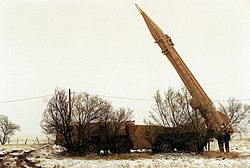References
- 1 2 3 4 5 "Al Hussein/al-Husayn". Federation of American Scientists. Archived from the original on 2 September 2019.
- 1 2 3 4 "Ballistic Missiles in Iran's Military Thinking". Wilson Center. Archived from the original on 22 May 2020.
- 1 2 3 4 5 "Iraq". NTI. Archived from the original on 31 October 2019.
- ↑ "Saddam Hussein's Development of Weapons of Mass Destruction". George W. Bush Presidential Archive. United States Government. Retrieved 19 January 2025.
